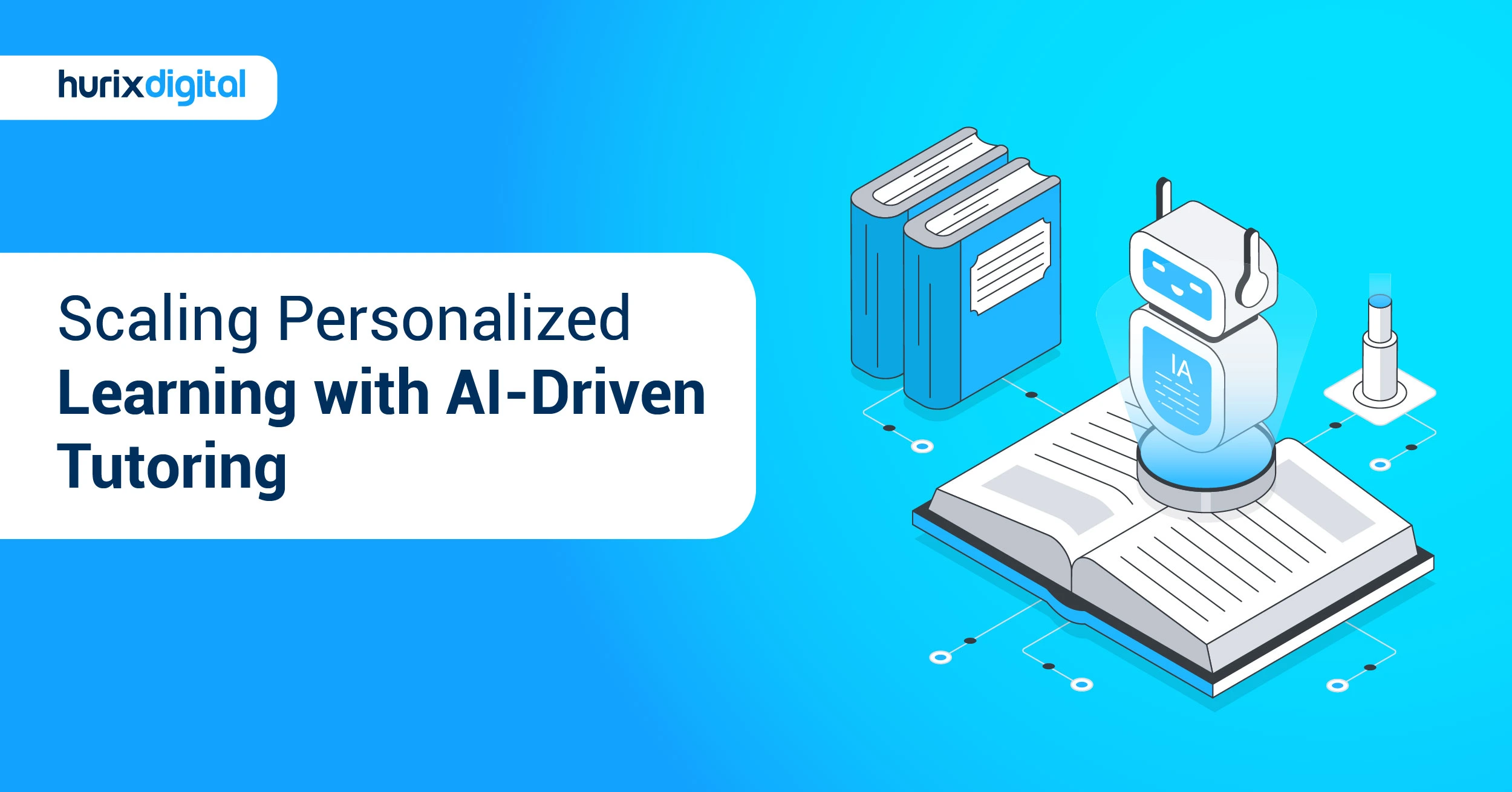
The Secret to Employee Success — Developing Impactful Workplace Courses
Summarize with:
Navigating obstacles and thriving are crucial for success in today’s dynamic workplaces. Yet many organizations struggle to keep up and adapt to constant change. Shockingly, 46% of executives confess they lack the necessary skills to confront disruptions.
This fact underscores the pressing need for proactive measures to build a robust framework. That’s where employee training comes into action. It is the cornerstone for building teams that can adapt, innovate, and excel.
Ready to discover the secrets of building organizational resilience? Join us as we delve into the crucial role of workforce training in building agile teams.
Table of Contents:
- What is Workplace Course Development?
- Why is Workplace Course Development Important?
- Why Workplace Resilience Matters?
- Key Elements Used in Workplace Course Development
- How to Encourage Employee Training: Step-by-Step Guide
- Level Up Your Teams with AI-Powered Employee Training
- What is Just-in-Time Employee Training?
- Benefits of Just-in-Time Employee Training
- How to Create Just-in-Time Learning Opportunities?
- Create an Active Learning Environment
- Understand What is Needed at the Moment
- Curate Short and Shareable Learning Content
- Include Real-World Scenarios for Better Understanding
- Seek Guidance From Subject-Matter Experts
- Automate the Training with a Learning Management System
- Address the Gaps by Encouraging Employee Feedback
- Examples of Just-in-Time Training
- Conclusion
What is Workplace Course Development?
Workplace course development is the process of identifying the learning needs of your workforce and designing blended learning courses and training programs accordingly.
The main purpose of this process is to equip your workforce with skills, abilities, and knowledge that will help them in the present and future as well.
Why is Workplace Course Development Important?
A company cannot thrive in this competitive world without a skilled or efficient workforce. To develop an efficient workforce, you need to constantly provide your employees with opportunities to strengthen their weak skills, learn new skills, and further build on their existing strong skills.
Workplace course development acts as a catalyst, transforming these opportunities into tangible results through blended learning courses.
In addition to being essential for success today, workplace course development is a necessity for the following reasons:
- Increases the productivity and engagement of your employees, resulting in performance improvement
- Makes your employees feel cared for and, as a result, improves their job satisfaction
- Reduces the cost of hiring – hiring is more expensive than training – as employees prefer to stay in your company, thus reducing your need to make new hires
- Improves your company’s culture by making it more diverse and inclusive, resulting in a cohesive workforce
Skilled workers who have gone through workforce course development provide top-notch services to your customers. This increases their satisfaction and conversion rate and ultimately causes a significant boost in your company’s return on investment.
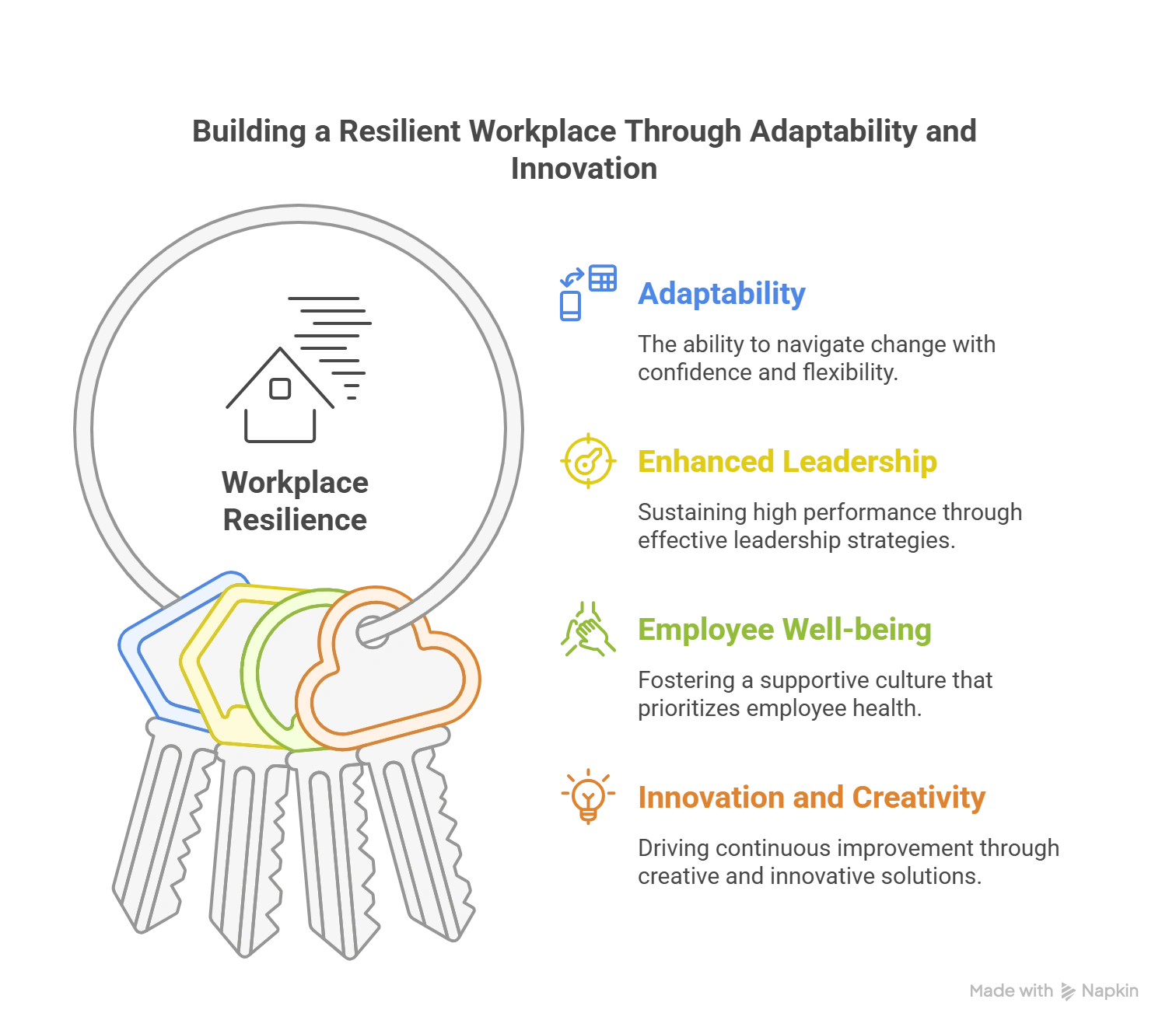
Why Workplace Resilience Matters?
It refers to how well your business can adapt to changes, recover from setbacks, and prosper in crises. Workplace resilience is pertinent for a brighter future – from staff well-being to productivity and beyond. Here are some key benefits:
1. Adaptability: Navigating Change with Confidence
Resilient teams display a remarkable capacity to adjust to new circumstances and emerging challenges. It enables them to maintain a competitive edge in evolving market conditions.
For example, many companies embraced remote work during the pandemic and changed their strategies to meet customer needs. This adaptability was vital to their success and business growth.
2. Enhanced Leadership: Sustaining High Performance
Did you know that peers, managers, and direct reports perceive resilient leaders as more influential? They have fantastic communication skills and promote cohesive teams, making them great role models.
For example, supervisors who capitalize on emerging opportunities can lay the foundation for long-term success. It demonstrates the power of resilience in enhancing business productivity.
3. Employee Well-being: Fostering a Culture of Support
Did you know a supportive environment mitigates stress, reduces burnout, and promotes a positive work culture? That’s right! Building workplace resilience can stimulate the well-being of employees.
For example, flexible work setups and mental health initiatives can lead to an engaged, resilient crew. It allows you to increase employee satisfaction, reduce turnover, and boost their morale.
4. Innovation and Creativity: Fueling Continuous Improvement
Resilient teams are more likely to embrace change and experiment with new approaches. It promotes a work culture where employees can experiment, learn, and improve.
For example, a project failure can cause you to rethink your processes or offerings, leading to ingenious solutions that address your customer and stakeholder needs.
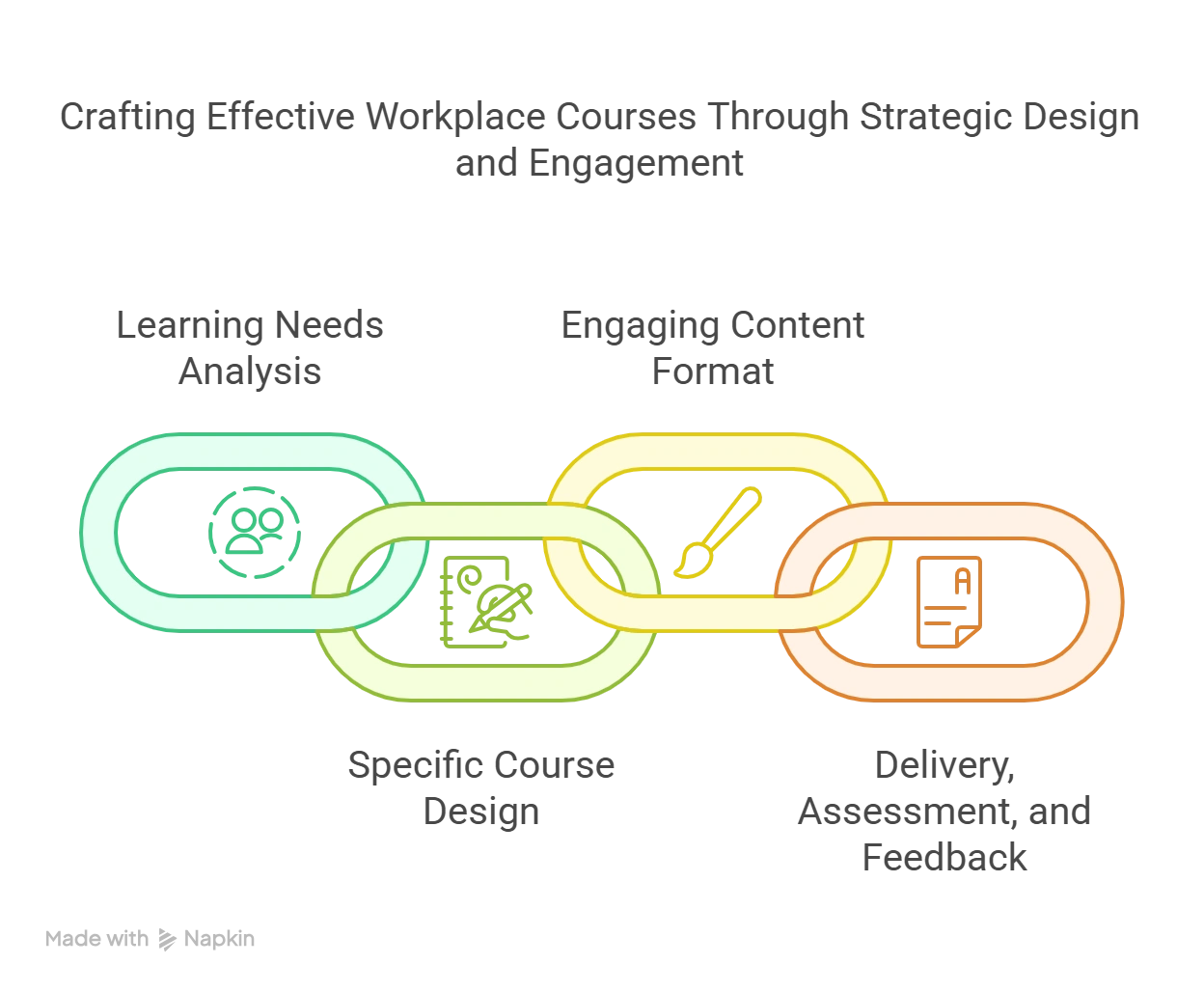
Key Elements Used in Workplace Course Development
Now that you know how crucial workplace course development is – let’s understand its key components so that you can effectively design workplace training courses.
1. Learning Needs Analysis
Learning needs analysis is an indispensable component of a workforce training course. Surveys, performance evaluations, and interviews can be used to conduct a needs analysis.
Study the analysis reports and the demographic information of your employees. This will help you understand your employees and better identify the skill gaps and abilities they lack and thus need to improve.
Besides an employee needs analysis, conduct an organizational needs assessment to know the skills and abilities your organization requires to meet its objectives. In the end, compare the two types of needs analysis and zero down on the common learning needs.
2. Specific Course Design
Once you know the common skill gaps and needs, use the information to establish learning objectives and goals. While setting the objectives, keep in mind what you want to achieve in terms of performance, skills development, and knowledge enhancement.
When coming up with goals, remember to use the SMART rule. The SMART rule stands for specific, measurable, achievable, realistic, and time-bound, and it helps you set clear goals.
Ultimately, the learning objectives and goals you develop will guide the design and outline of your course.
3. Engaging Content Format and Matter
It’s no secret that employees get bored and stop paying attention when an instructor keeps speaking for a long time. How can you ensure this doesn’t happen with your training course? The key is to create engaging content formats and matter.
Based on your course outline and aspects like personalization and varied learning styles, decide on a course format like videos, presentations, animations, manuals, and more.
For creating and presenting the content matter, take the help of subject matter experts (SMEs) and mediums like:
- Interactive e-Manuals: These contain informative training content and features like highlight, search, read aloud, and more.
- Game-Based Learning: This type involves using game-based elements and activities like puzzles to upskill your employees. Learning by doing keeps your employees motivated and hooked on the learning process.
- Scenario-Based Learning: This type involves exposing employees to simulated scenarios, where they can only forge forward by using their knowledge and critical thinking skills. It provides an immersive learning experience to your employees.
- Blended Learning: It involves a blend of the interactive components of eLearning and instructor-led training, adding an element of human touch to the learning experience.
4. Delivery, Assessment, and Feedback
Once you have selected content formats and created content matter, ensure the training course is accessible on every smart device, including mobiles, laptops, tablets, and computers. Then, provide your employees with access to the training course.
When the training program is complete, evaluate your employees’ performance with interactive assessments and quizzes. Additionally, assess the performance of the training course by taking feedback from your employees through surveys, interviews, and other mediums.
Analyze the feedback to gain insights into what worked well and what didn’t and thus needs improvement. Use these valuable insights to design future workplace training courses.
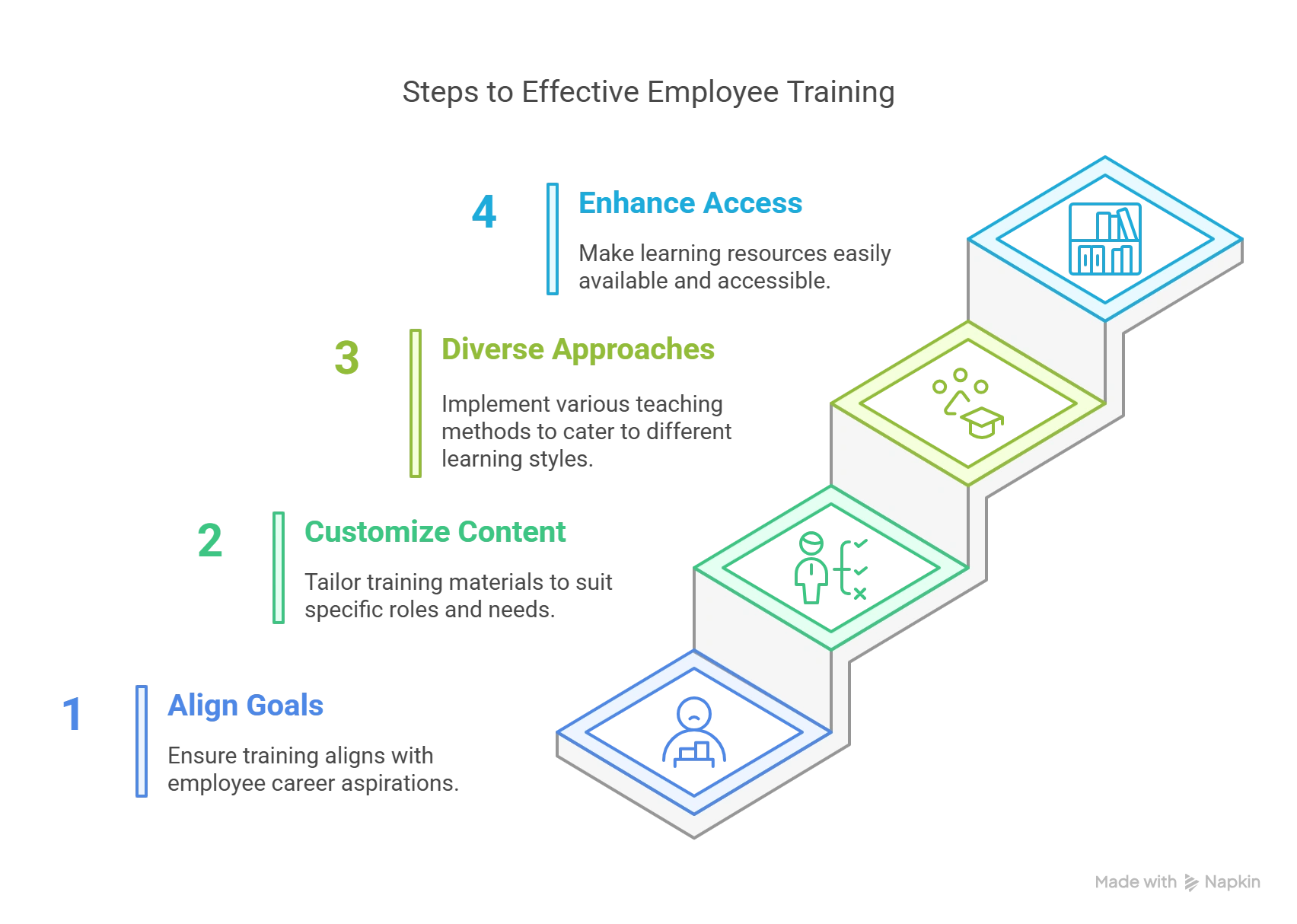
How to Encourage Employee Training: Step-by-Step Guide
To ensure employee engagement and program relevance, consider these key factors:
1. Align Training with Employee Goals
- Encourage employees to define their professional goals and tailor the training accordingly.
- Include activities and upskilling prospects to enhance employee investment in the training.
2. Customize Content for Relevance
- Design concise and pertinent modules that address specific skill gaps.
- Use an agile learning management system (LMS) to assign personalized content.
- Encourage micro-learning for increased engagement and participation.
3. Accommodate Diverse Learning Approaches
- Consider different styles and preferences, such as verbal, visual, and aural learning.
- Develop training materials in various formats to cater to different learners. It can include webinars or written, visual, and audio content.
4. Enhance Access to Learning Materials
- Recognize the evolving nature of the workplace, including remote work and varied schedules.
- Provide round-the-clock access to training materials through various devices. It will help you accommodate individual learning schedules and locations.
Level Up Your Teams with AI-Powered Employee Training
Hurix Digital offers advanced AI-based training solutions to equip your workforce for the future. Here’s how we can elevate your team’s capabilities:
- Tailored and adaptive learning paths catering to individual job demands. It ensures relevant skill development.
- Real-time feedback to help organizations track progress and pinpoint areas for enhancement.
- Inclusive and captivating learning experiences, encouraging high participation. It boosts knowledge retention across diverse teams.
- Scalable solutions catering to changing training needs and accommodating growth.
- Expertise in LMS in delivering and managing training content.
- Thorough understanding of eLearning and corporate solutions to make well-informed training decisions.
What is Just-in-Time Employee Training?
Just-in-time (JIT) training is a part of the L&D concept that focuses on needs-related quick learning. This mode of employee training is all about learning skills which are required at the moment.
It avoids potentially irrelevant content and streamlines the learning material for skill development. The content for this training can take the form of microlearning, mini video clips, or bite-sized content to digest.
As a part of on-the-job training, it answers an immediate problem. The approach provides the employee with enough information to get the job done right away, making it highly effective for competitive teams. According to a study conducted by CEB, a division of Gartner, 57% of employees prefer just-in-time training to ensure efficiency.
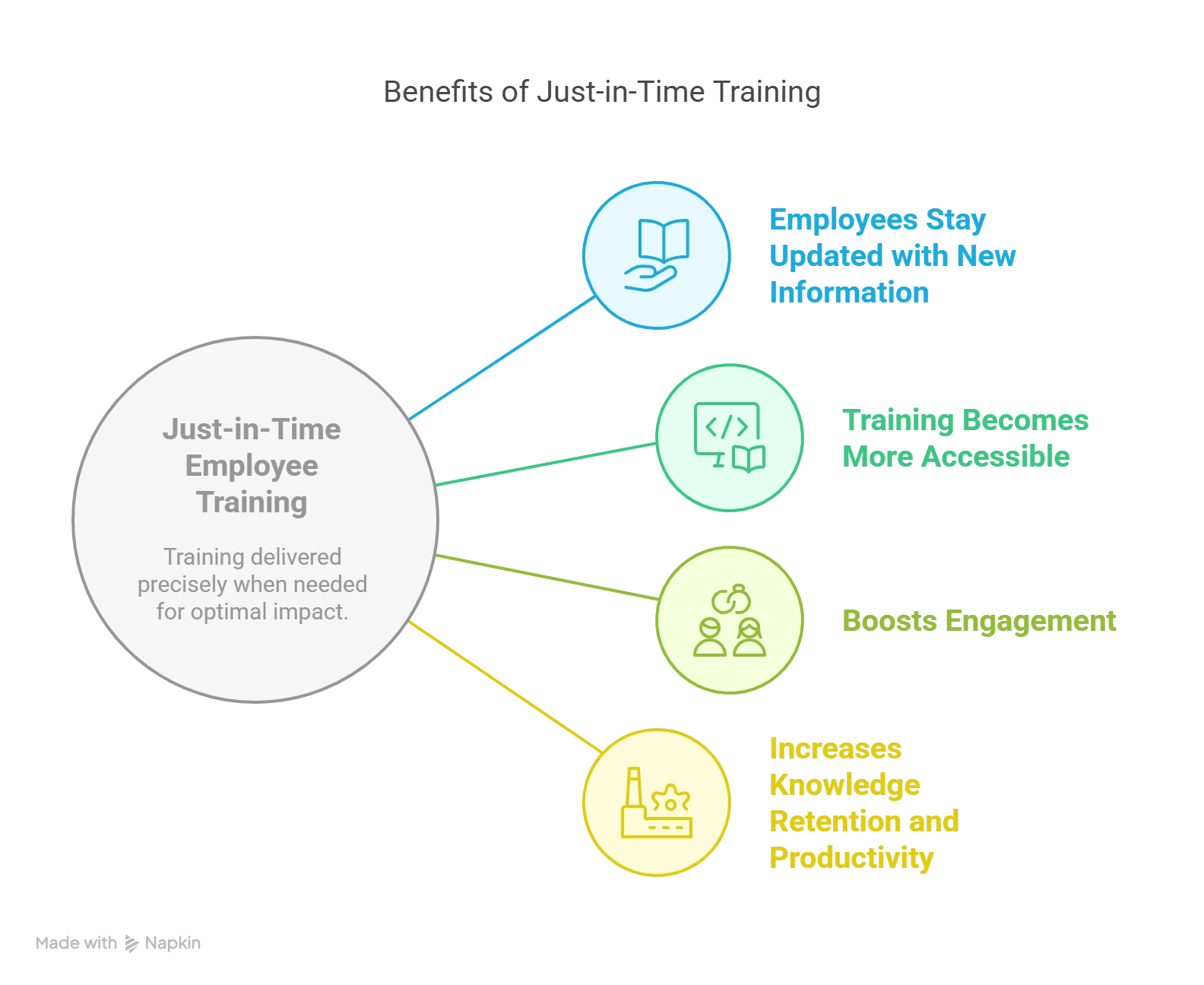
Benefits of Just-in-Time Employee Training
With ready-to-access content, employees feel more confident in their tasks, increasing workplace efficiency. Traditional training models include recalling from memory, which is not always useful and takes up a lot of time. Just-in-time training has multiple benefits that help with employee productivity. Some of these have been discussed below.
1. Employees Stay Updated with New Information
Just-in-time training broadens the repertoire of employees and helps them adapt to changing industry trends.
2. Training Becomes More Accessible
One of the main benefits of just-in-time training is its flexibility. Knowledge and skills can be imparted through real-life examples at any optimal moment.
3. Boosts Engagement
Short-term or gamified content keeps the learner invested in the course. This leads to increased Engagement, which yields better post-training results.
4. Increases Knowledge Retention and Productivity
Just-in-time training is linked with knowledge retention as it helps to combat the forgetting curve. It delivers the content at the point of need and helps the employees with immediate application of solutions.
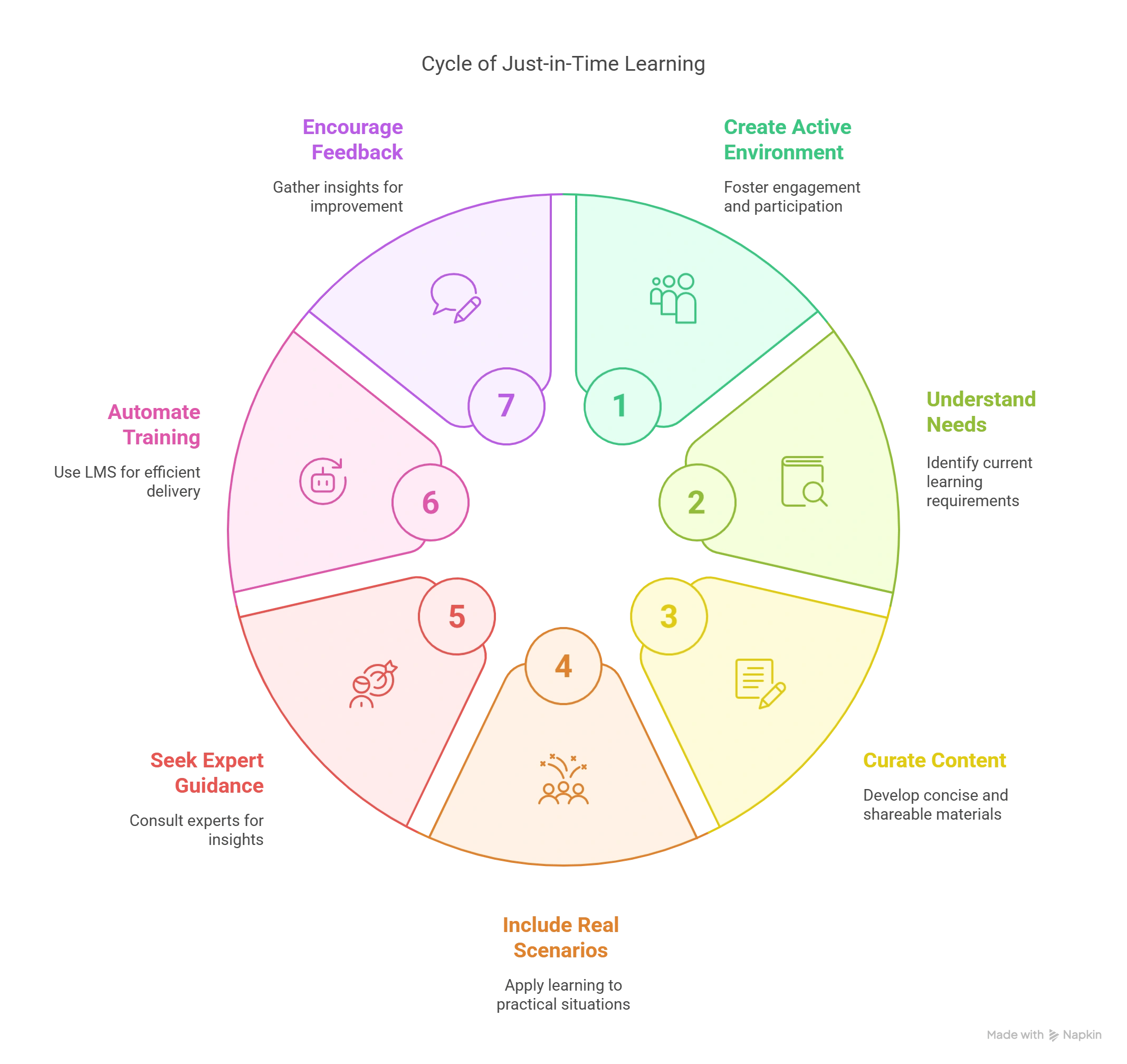
How to Create Just-in-Time Learning Opportunities?
The Just-in-time employee training approach can be applied to different organizations without compromising learning quality.
Here’s a simple guide on implementing a just-in-time training module for performance improvement.
1. Create an Active Learning Environment
The first step is to create a work environment that encourages active learning. Facilitate discussions and encourage employees to participate in company-wide seminars or workshops.
A collaborative approach to learning will soon become part of daily habits. Such habits can be formed by setting up shareable QR codes to offer teachable moments in the workplace. Employees can search for the correct dosage chart or a quick link for handling emergencies.
2. Understand What is Needed at the Moment
Analyse and document the developmental needs of your organization. Examine skill gaps, performance reviews, and job descriptions to explore the areas that need improvement.
Once you’ve identified the issues, it is time to set learning objectives and clear expectations. Whether it’s improving communication skills or learning advanced-level software tasks, ensure that every objective will produce necessary changes post-training.
3. Curate Short and Shareable Learning Content
Talent professionals often advise that training content should be short and crispy. This helps address the short attention spans and retain various chunks of content.
Employee training should involve microlearning, which includes short video clips, checklists, tests, and gamified content. This motivates individuals to finish their tailored courses on time. According to a survey by Forrester Research, 75% of people choose video over reading print.
4. Include Real-World Scenarios for Better Understanding
It is important to provide real-life examples of every topic to help you understand it better. The training session might not produce the desired results without context or practice opportunities.
A bulleted list of scenarios or showing how the knowledge can be applied to a given framework builds employee confidence. Discuss all the problems one might encounter while working and the possible solutions.
5. Seek Guidance From Subject-Matter Experts
Seek guidance from partners and subject matter experts to create useful content for just-in-time training. Using the expertise provided by SMEs is a great way to ensure that the goals will be met. With a wide range of skills and background knowledge, SMEs can create a tailored quick course for training-related needs.
6. Automate the Training with a Learning Management System
Choose smart technology like Learning Management Systems (LMS) over manual content or training materials delivery. LMS automation allows you to deliver the content across teams and individuals depending on exactly where they need it.
The system ensures that the training materials land in the right hands whenever required. Without any delays, companies can upskill teams or elevate the onboarding process with automated employee training materials.
7. Address the Gaps by Encouraging Employee Feedback
A conversational dialogue with the organization’s employees will reveal the needs at the surface level. Ask for employee feedback to ensure that the upcoming training sessions will address their career-related needs.
This is a great way to illuminate the skill or knowledge gaps present at an individual level. Gather insights from teams and employees about what’s working for them and turn opinions into action. This makes the training relevant and keeps the whole organization in the loop.
Examples of Just-in-Time Training
Let’s take a look at some examples where employee training becomes crucial for the smooth functioning of work.
- In the healthcare sector, just-in-time learning provides valuable tools for determining the proper dosage or potential side effects of medicine. Healthcare workers also learn about navigating new medical devices and handling equipment correctly. In addition, just-in-time training offers simulations through which learners can produce better learning outcomes.
- In the manufacturing sector, employees working on the production floor can quickly access safety protocols if there’s a hazard. Just-in-time training sets the environment for safely dealing with potential hazards like conveyor belts, compressors, and forklifts.
- Just-in-time training is a great way to facilitate employee onboarding. It reduces interruptions, as employees can easily look up information without always consulting their peers. Content about management profiles, job descriptions, how to use company communication tools like Slack or Trello, and more can be included.
- In the tech industry, just-in-time training provides instant technical support for staff. After the training, employees can make quick decisions, whether handling a consumer complaint or troubleshooting modules.
Conclusion
Now that you are familiar with the key elements of workplace course development, 70% of employees would consider joining another company willing to invest in their training and development and leave their current job.
In this scenario, if you want to be the best-performing company in this world, unwavering commitment to workplace course development is paramount. And if you want to save valuable time and money while doing so, outsourcing workforce development services from Hurix Digital can help.
Hurix Digital offers customized training solutions to meet your company’s unique needs. It provides informative learning experiences with engaging instructional strategies to empower your employees with desired skills and knowledge and increase your return on investment. As a firm believer in delivering rich and captivating training experiences, Hurix Digital is the trusted preference of companies like FedEx Express, Deloitte, JP Morgan Chase and Co., and more.
To know more about workplace training solutions, get in touch with Hurix Digital.
Summarize with:

Senior Vice President
Julia brings over 20 years of global experience in digital learning and business strategy. She specializes in client success, enterprise learning solutions, and driving growth through innovation, with a focus on AI, VR, and emerging technologies across diverse industry verticals.
 Upcoming Masterclass | Build an Army of Brand Evangelists using Training & Development | November 20th, 8:30 AM PDT | 11:30 AM EDT | 10:00 PM IST
Upcoming Masterclass | Build an Army of Brand Evangelists using Training & Development | November 20th, 8:30 AM PDT | 11:30 AM EDT | 10:00 PM IST




